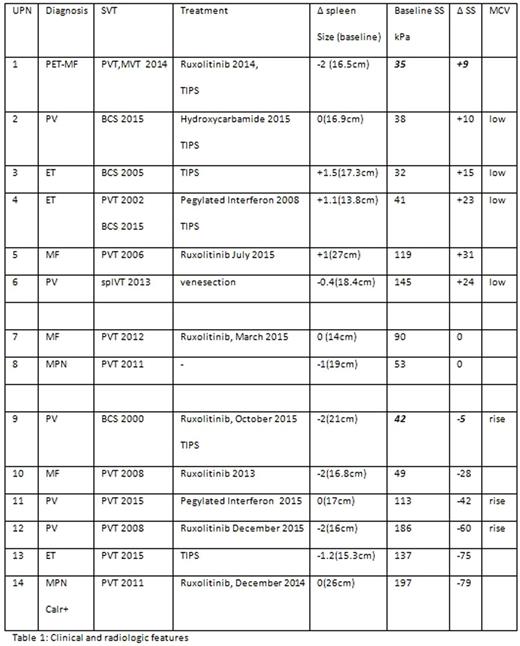Abstract
Introduction: Myeloproliferative neoplasms (MPN) account for the majority of non-cirrhotic and non-malignant Splanchnic vein thrombosis (SVT). SVT comprises extrahepatic portal vein obstruction (EHPVO), Budd-Chiari syndrome (BCS), mesenteric vein thrombosis (MVT) and splenic vein thrombosis (SpVT). 30% of EHPVO and 45% BCS are attributable to MPN. Portal hypertension (PH) is a major complication of SVT and hepatic and splenic elastography is increasingly used as a non-invasive tool for the characterization of hepatic fibrosis and PH. We had already established in 17 patients with chronic liver disease (CLD) that SS was the only predictor of clinically significant PH (CSPH) with an AUROC of 0.908, SE=0.45, p<0.0001, 95% CI 0.821-0.996, Cut-off 44.3 kPa, sensitivity 88%, specificity 85%. We wished to explore the role of tissue stiffness in characterizing splenomegaly in MPN patients with SVT.
Methods: As part of an observational study of patients with MPN-SVT (Mascot study) from September 2015 we assessed 18 patients with MPN-SVT for spleen stiffness (SS) and spleen size (SSz) using point shear wave elastography (ElastoPQ Phillips Healthcare system). 14 patients had measurements at two time points 3-8 months apart (median 4.5m). Their clinical and radiologic details are presented in Table 1. SVT was diagnosed 1-16 years prior to the investigations (median 5 years). Patients were treated with LMWH and warfarin. Most patients also received Aspirin at the outset and 2/14 patients had thrombolysis in the acute phase. Review of SVT with imaging by CT/MR was undertaken at 6-12 monthly intervals. MPN was diagnosed on the basis of blood and bone marrow morphology and molecular analysis. 1 patient had CALR mutation, the others JAK2V617F mutation. Treatment included venesection, Hydroxycarbamide, Pegylated Interferon and Ruxolitinib.
Results: 8/14 were male, median age 45 years. All patients had splenomegaly at baseline. All patients showed stable or improved appearances of the site of thrombus with patent TIPS on follow-up imaging.
9/14 were on MPN directed medication; median time between commencing medication and 1st SS measurement was 3 months (range -3m to 7 yrs) including 1 patient who commenced Ruxolitinib 3 months after 1st assessment but 7 months before the 2nd assessment (patient 12).
In 6/14 patients SS worsened (pts 1-6, Table 1), SSz was stable or worse. 4/6 had TIPS and 4/6 had cytoreductive treatment including 2 receiving Ruxolitinib.
In 6 patients SS reduced along with a reduction in SSz (pts 9-14). 2 had TIPS and 5/6 had cytoreductive treatment including 4 receiving Ruxolitinib.
Patients with increasing SS over time also had microcytic erythrocytosis that persisted over the period of measurement. Patients with improving SS had improvement in the MCV leading to normal values of RBC and MCV (Fig 1).
Conclusions:
In this small pilot study on a cohort of well characterised MPN-SVT patients we have assessed SS and considered clinical variables affecting this. This study shows that
1. Spleen elastography provides a novel method of characterising the spleen. In patients with CLD it correlates well with clinically significant PH.
2. All patients with MPN-SVT have residual splenomegaly
3. Patients had no recurrence of the SVT after adequate anticoagulation was instituted.
4. More patients with reduction in SS received JAK2 inhibitor drugs.
5. Reduction in SS is not a consistent feature of PH reduction via TIPS.
6. Persistent microcytic erythrocytosis is seen in the patients with worsening spleen stiffness and improvement in patients with improving stiffness.
7. The dynamics of splenomegaly in these patients remains unclear.
Discussion: TIPS reduces portal pressure and in PH related to CLD and thereby reduces SSz. In our patients this has not been a consistent result. Previous studies have shown a reduction in SSz with Ruxolitinib. In our patients the reduction is size and stiffness is noted in patients on Ruxolitinib/Pegylated Interferon but it is not consistent. This lack of response in some patients occurs despite normalisation /improvement of counts. The persistence of splenomegaly with abnormal stiffness in the face of TIPS and cytoreduction is puzzling and worthy of longitudinal studies using elastography which may offer valuable insights into the role and behaviour of the spleen in these disorders.
Sekhar:Novartis: Research Funding.
Author notes
Asterisk with author names denotes non-ASH members.



This feature is available to Subscribers Only
Sign In or Create an Account Close Modal